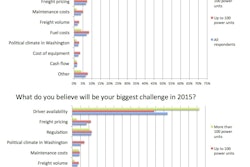Click here to download the full copy of CCJ’s 2015 Trucking Outlook report.

The trucking industry got an early Christmas present last month when the HOS rollback was signed into law as part of a spending package, but whether carriers will be able to recover the estimated 3 to 5 percent loss in productivity after the July 2013 rules went into effect remains to be seen.
“When we talk about the netting out of the HOS rollback, we are talking about regaining 1 or 2 percent,” says Meil. “Once you’ve made those operational changes, it takes a while to undo what you’ve done. Still, the longer-term potential remains to recapture the 3 to 5 percent.”
Although an increase in productivity will restore some capacity to the market, Broughton doesn’t think it will be enough to discourage higher freight rates. “It doesn’t hurt pricing right now because when you get empty, you are choosing from 15 loads,” he says. “So if we can improve capacity by 3 percent, suddenly you’re picking from 12 loads. There still will be more loads than trucks, and the trucks will be more profitable because the driver again has more flexibility in how to accomplish his work.”
 Click here or the photo to download the full copy of CCJ’s 2015 Trucking Outlook report.
Click here or the photo to download the full copy of CCJ’s 2015 Trucking Outlook report. Still, several items remain on the regulatory drawing board, including a drug and alcohol clearinghouse set to become final in September to prevent hiring drivers who previously have tested positive for substance abuse and haven’t completed a recovery program, as well as a minimum insurance increase that would double a carrier’s minimum liability coverage from $750,000 to $1.5 million or more. If published, that rule could jeopardize small carriers and potentially put many of them out of business.
“I fear the current government,” says one small for-hire carrier survey respondent. “The fear of insurance premiums for cargo/liability going up, as well as all the new laws that get passed before we even know about the last one, makes me say, ‘I’m not going to do this much longer.’ ”
Also on tap for 2015 are two rules ATA is supporting, including speed limiters for heavy-duty vehicles and the long-awaited electronic logging device mandate.
“The best numbers I’ve seen constitute a net productivity loss of 3 to 4 percent,” says Meil on the topic of ELD implementation. “Your gain is in the form of a better management information tool that provides better utilization, and over the longer term, you may be able to claw back 50 percent of your upfront productivity loss.”
“I have yet to see a regulation that increases capacity or lowers a carrier’s costs,” says Costello. “The cumulative effect of all these regulations – some of which ATA supports and some it doesn’t – are becoming a larger part of a carrier’s operational costs.”
<










